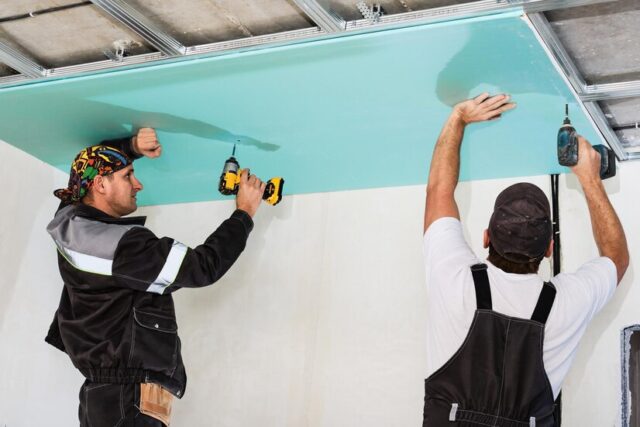Drywall, also known as plasterboard or wallboard, is a popular building material used in the construction industry. It is made of gypsum plaster pressed between two thick sheets of paper, creating a smooth and durable surface for walls and ceilings. Drywall has been widely used since the 1950s due to its ease of installation, cost-effectiveness, and versatility. However, like any other building material, it has its own set of advantages and disadvantages. In this blog post, we will delve into what drywall is, its various uses, and its pros and cons.
The History and Composition of Drywall
History of Drywall
The use of drywall can be traced back to the early 1900s when it was first invented by Augustine Sackett. However, it was not until the 1950s that it gained widespread popularity in the United States. Before drywall, walls were typically made of lath and plaster, which required skilled labor and a longer installation time. With the introduction of drywall, construction became faster, more efficient, and less expensive.
Composition of Drywall
Drywall is primarily composed of gypsum, a soft sulfate mineral, which is then mixed with water and pressed between two sheets of paper. The inner layer of paper is usually made of recycled materials, while the outer layer is made of heavy-duty paper. This composition makes drywall lightweight, fire-resistant, and easy to work with.
Types of Drywall
There are several types of drywall available in the market, each with its own unique properties and uses. Some of the most common types include:
Regular Drywall
Regular drywall, also known as standard drywall, is the most commonly used type of drywall. It is available in various thicknesses, ranging from 1/4 inch to 3/4 inch, and is suitable for most interior walls and ceilings.
Moisture-Resistant Drywall
As the name suggests, moisture-resistant drywall is designed to withstand high levels of humidity and moisture. It is commonly used in bathrooms, kitchens, and other areas prone to water exposure.
Fire-Resistant Drywall
Fire-resistant drywall, also known as Type X drywall, contains glass fibers and other additives that make it more resistant to fire. It is typically used in commercial buildings and multi-family residences to meet fire safety codes.
Soundproof Drywall
Soundproof drywall, also known as acoustic drywall, is designed to reduce noise transmission between rooms. It is commonly used in music studios, home theaters, and other areas where sound insulation is necessary.
Advantages of Using Drywall
Easy Installation
One of the main advantages of using drywall is its ease of installation. Unlike traditional lath and plaster, which requires skilled labor and a longer installation time, drywall can be installed by anyone with basic carpentry skills. The process involves cutting the drywall sheets to size, attaching them to the wall or ceiling with screws, and then covering the seams with joint compound and tape.
Cost-Effective
Drywall is also a cost-effective building material. It is relatively inexpensive compared to other materials such as wood paneling or brick. Additionally, its lightweight composition makes it easier and cheaper to transport and install, reducing overall construction costs.
Versatility
Drywall is a highly versatile material that can be used for various purposes. It can be easily cut and shaped to fit any space, making it suitable for both straight and curved walls. It can also be painted, wallpapered, or textured to achieve different looks and styles.
Fire-Resistant
As mentioned earlier, some types of drywall, such as Type X, are fire-resistant. This means that they can withstand high temperatures and prevent the spread of fire, giving occupants more time to evacuate a building in case of a fire emergency.
Easy to Repair
Drywall is also easy to repair in case of damage. Small holes or cracks can be easily patched up with joint compound and sanded down to create a smooth surface. Larger damages may require replacing the entire sheet, but the process is still relatively simple and cost-effective compared to other materials.
Disadvantages of Using Drywall
Prone to Water Damage
While drywall is moisture-resistant, it is not completely waterproof. If exposed to prolonged water exposure, it can become damaged and even grow mold. This makes it unsuitable for areas with high levels of humidity, such as basements or bathrooms. In such cases, alternative materials like cement board or greenboard should be used.
Not Durable
Compared to other building materials such as concrete or brick, drywall is not as durable. It is prone to dents, scratches, and other forms of damage, especially in high-traffic areas. This makes it unsuitable for use in commercial buildings or areas with heavy foot traffic.
Difficult to Hang Heavy Objects
Due to its lightweight composition, drywall is not suitable for hanging heavy objects such as shelves or cabinets. The weight of these objects can cause the drywall to crack or even collapse. Special anchors or braces must be used to distribute the weight and prevent damage.
Uses of Drywall
Drywall has a wide range of uses in both residential and commercial construction. Some of its common applications include:
Interior Walls and Ceilings
Drywall is most commonly used for interior walls and ceilings in homes, offices, and other buildings. Its smooth and even surface provides a perfect canvas for paint, wallpaper, or other decorative finishes.
Soundproofing
As mentioned earlier, soundproof drywall is commonly used in areas where noise reduction is necessary. Its dense composition helps to absorb sound and reduce noise transmission between rooms.
Fire Protection
Drywall is also used for fire protection purposes, especially in commercial buildings. Its fire-resistant properties can help contain a fire and prevent it from spreading to other areas of the building.
Insulation
In addition to its fire-resistant properties, drywall also has insulating properties. It can help regulate temperature and reduce energy costs by keeping heat inside during the winter and outside during the summer.
Conclusion
Drywall is a widely used building material that has revolutionized the construction industry. Its ease of installation, cost-effectiveness, and versatility make it a popular choice for interior walls and ceilings. However, it is not without its drawbacks, such as susceptibility to water damage and lack of durability. Before using drywall in any construction project, it is essential to consider its advantages and disadvantages and choose the appropriate type for the intended purpose. With proper installation and maintenance, drywall can provide a smooth and durable surface for years to come.






